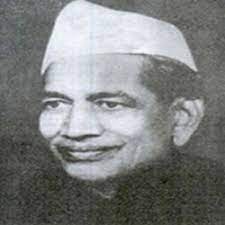Siyaramsharan Gupt (4 September, 1895 – 29 March, 1963) was one of the distinguished Hindi writers. He was the younger brother of another Hindi literature doyen Maithilisharan Gupt.
Biography
Siyaramsharan Gupta was born in the family of Seth Ramcharan Kanakne in Chirgaon, Jhansi. After completing his elementary education, he learned Gujarati, English and Urdu languages at home. In 1929 AD, he came in contact with the Father of the Nation Mahatma Gandhi and Kasturba Gandhi. He also stayed in Wardha Ashram for some time. In 1940, Netaji Subhash Chandra Bose was welcomed in Chirgaon. He also came in contact with Saint Vinoba Bhave. His wife and sons had died untimely, so he became a poet of sorrow and compassion. In 1914 he wrote his first work, Maurya Vijay. In 1910, his first poem ‘Indu‘ was published.
Literary Service
Due to the passing of childhood in Chirgaon (Jhansi), his love for Bundelkhand’s valor and nature was natural. Guptji’s personality developed from the Vaishnava rites and Gandhism. Gupt was a self educated poet. The poetry of Maithilisharan Gupt and his era was adopted by Siyaramsharan as it is. Therefore, all his poetry is based on the Dwivedi era Both the Gupt brothers, being influenced by the new Hindi movement Chhayavad, have preserved their historical poetic form. Even from the point of view of thought, Siyaramsharan Ji, like the elder brother, was influenced by Gandhi’s sorrow, patriotism, world love, world peace, change of heart, truth and non-violence for life. His poetry is actually a verse attempt to express Gandhian loyalty.
Gupt Ji’s language style is simple, simple literary Khariboli Hindi. He has used practical terminology in his writings. The style of his compositions is realistic, succinct, descriptive, thought-provoking, pictorial and emotional.Gupt Ji’s Maurya Vijay (1914 AD), Anath (1917), Durvadal (1915-24), Vishad (1925), Ardra (1927), Atmotsarga (1931), Mrinmayi (1936), Bapu (1937), Unmukt (1940) (Maurya Vijay and Nakula) and others are narratives in verse. In the rest also the thread of the story is visible in some form or the other. The personal sorrow of the poet due to human love, being one with the social sorrow is described. In the nostalgia the poet has expressed in the description of his widower’s life and the pain arising out of the death of his daughter Rama in Ardra, which are not less poignant, but not as artful as Bachchan’s Priyaviyoga and Nirala ji’s “Sarojsmriti”. Thus, because of the sincerity of his heart, his works on subjects like the poverty of the public, anger against evils, world peace, described by Gupt Ji can teach a lesson to any progressive poet. For pure sentiments in Hindi, the compositions of Gupt Ji will be remembered. They could not depict the makeup and fierce aspects of life, but the simple and direct method on which the sense of compassion towards life has been expressed in Gupta ji has made for him a special place in Hindi poetry. He is a representative poet.







Leave a Reply